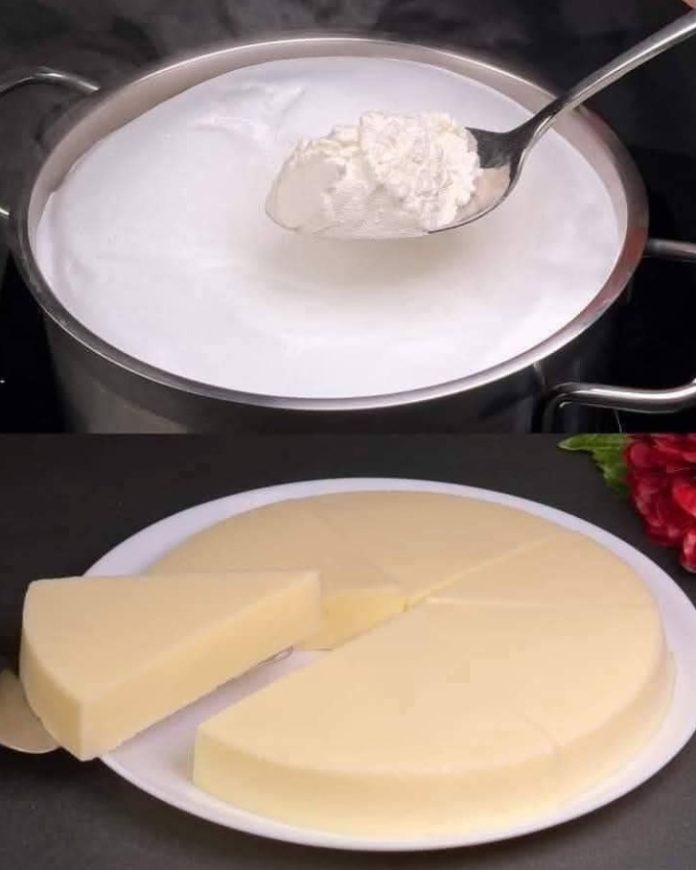If you’re a cheese lover, you know how irresistible a creamy, flavorful chunk of cheese can be. But have you ever considered making your own cheese? It’s easier than you think and doesn’t require any fancy equipment or long hours of preparation. In fact, you can make fresh cheese from just one liter of milk in a matter of minutes! Yes, you heard that right—within 5 minutes, you can have a delectable cheese ready to eat.
This homemade cheese recipe is not only cost-effective but also incredibly versatile and customizable, allowing you to create a variety of cheese types to suit your personal preferences. Here’s why you’ll love making cheese at home!
Why You’ll Love This Recipe
Making cheese at home is truly a game-changer. Here are a few reasons to give it a try:
- Cost-Effective: Why spend money on store-bought cheese when you can turn a simple liter of milk into a delicious, high-quality cheese at home? This method helps you save money while enjoying freshly made cheese.
- Quick and Easy: Forget about complex processes and waiting for hours. This simple method allows you to make cheese in just 5 minutes.
- Customizable: Want a tangier cheese? Or perhaps a milder flavor? This recipe allows you to adjust the texture and flavor to your liking, making it the perfect cheese for any dish.
- Fresh and Healthy: Skip the preservatives and additives often found in store-bought cheeses. With homemade cheese, you’re in control of all the ingredients.
- Impress Your Friends: There’s nothing like serving up homemade cheese at a dinner party or as a thoughtful gift. It’s a unique way to impress your guests and showcase your culinary skills.
Ingredients You’ll Need
The beauty of this homemade cheese recipe lies in its simplicity. You don’t need any special tools or hard-to-find ingredients. Here’s what you’ll need:
- 1 liter of whole milk (Fresh and full-fat milk is recommended for the creamiest cheese, but you can also use other types of milk depending on your preferences.)
- 1 tablespoon of lemon juice (Alternatively, you can use vinegar as a substitute.)
- 1/2 teaspoon of salt (This is optional, depending on how salty you like your cheese.)
Optional Add-Ins:
- Fresh herbs like basil, chives, or oregano for an aromatic twist.
- A pinch of black pepper or chili flakes for a spicy variation.
- Sweet options like honey, maple syrup, or cinnamon for a dessert-worthy cheese.
Step-by-Step Instructions
Ready to make your very own homemade cheese? Follow these easy-to-follow instructions, and you’ll be enjoying fresh cheese in no time.
Step 1: Heat the Milk
Begin by pouring the milk into a saucepan. Set it over medium heat and stir occasionally to prevent the milk from sticking to the pan. Heat the milk until it reaches about 80–90°C (176–194°F)—just before it begins to boil. You’ll notice small bubbles forming around the edges.
Step 2: Add the Acid
Once the milk is heated, remove the saucepan from the stove. Slowly pour in the lemon juice (or vinegar). Stir gently as the milk starts to curdle. Within 1–2 minutes, the milk will separate into curds (the solid part) and whey (the liquid part).
Step 3: Strain the Curds
Place a colander over a bowl and line it with cheesecloth or a clean kitchen towel. Carefully pour the curdled milk mixture into the colander. Allow the curds to drain for a few minutes until the whey has been fully separated. If you prefer a firmer cheese, you can let the curds drain for a bit longer.
Step 4: Season and Shape
Transfer the drained curds to a mixing bowl. Add salt and any additional seasonings or flavorings you’d like. Gently mix everything together to combine. If you’d like a firmer texture, you can press the curds into a mold or shape them into a ball using your hands.
Step 5: Enjoy or Store
Your fresh cheese is ready to eat! Spread it on bread, crumble it over a salad, or use it in your favorite recipe. If you have leftovers, store them in an airtight container in the fridge for up to 3–5 days.
Why This Recipe Works So Well
This cheese is made through an acid coagulation process. When the acid—either lemon juice or vinegar—is added to the milk, it causes the proteins (casein) to denature and clump together, forming curds. This is the same process that takes place in the making of cheeses like paneer, ricotta, and farmer’s cheese. The beauty of this method is that it doesn’t require any aging, making it quick and easy to prepare while still yielding a fresh, creamy cheese.
Variations to Try
While the basic recipe is delicious on its own, there are plenty of ways to get creative with it. Here are a few ideas to make your cheese even more special:
- Paneer: For a firmer, sliceable cheese, press the curds more firmly. Paneer is perfect for Indian dishes like saag paneer or tikka masala.
- Ricotta: Use slightly less acid and strain the curds quickly for a creamier texture. This variation is ideal for lasagna or even desserts like cheesecake.
- Herbed Cheese: Add a burst of flavor by mixing in fresh herbs like basil, dill, or chives. This makes a delightful spread for crackers or toast.
- Sweet Cheese: If you have a sweet tooth, try adding honey, maple syrup, or vanilla extract to create a dessert-friendly cheese.
- Flavored Cheese: Experiment with seasonings like smoked paprika, garlic, or jalapeños to create a bold, savory cheese.
Tips for Success
- Use Fresh Milk: Fresh, full-fat milk yields the best results, giving your cheese a creamy texture and rich flavor. Try to avoid ultra-pasteurized milk, as it may not curdle properly.
- Don’t Overheat the Milk: Heating the milk too quickly or allowing it to boil can affect the curdling process. Keep the heat at a steady medium and be patient.
- Save the Whey: Don’t throw away the leftover whey! It’s packed with nutrients and can be used in smoothies, soups, or even for baking.
- Experiment with Acids: Lemon juice provides a mild, tangy flavor, while vinegar gives the cheese a sharper taste. Try both to see which one you prefer.
- Press for Firmness: If you prefer a firmer cheese, wrap the curds in cheesecloth and press them with a heavy object, like a cast-iron skillet, for 1–2 hours.
Serving Suggestions
This fresh homemade cheese is incredibly versatile and can be used in many dishes. Here are some ideas to elevate your meals:
- Breakfast: Spread it on toast with a drizzle of honey or sprinkle it over fresh fruit for a wholesome start to your day.
- Salads and Wraps: Crumble the cheese over salads or use it to fill wraps for a light, nutritious lunch.
- Pasta: Use it in lasagna, stuffed shells, or as a topping for pizza to add a creamy, rich texture.
- Snack Time: Pair the cheese with crackers, olives, or a charcuterie platter for a simple yet elegant snack.
- Desserts: Sweeten the cheese with honey or drizzle with chocolate for a decadent dessert.
Final Thoughts
Homemade cheese is one of the simplest, most rewarding things you can make in the kitchen. With just a few basic ingredients and minimal time, you can create a fresh, flavorful cheese that’s free from preservatives and packed with nutrition. Whether you’re saving money, experimenting with new recipes, or simply looking for something fun to do, this cheese-making process is sure to impress.
Next time you’re tempted to buy cheese from the store, consider making your own instead! In just 5 minutes and with just a liter of milk, you’ll have your very own fresh cheese ready to enjoy. Try this recipe today and discover the joy of homemade cheese!
Have you tried making cheese at home? Share your tips, variations, and thoughts in the comments below. Happy cheesemaking!










